Strategic Market Analysis for Early Intervention Disability Services
VerifiedAdded on 2023/03/30
|9
|1729
|370
Report
AI Summary
This report provides a comprehensive analysis of the market for early intervention disability services in Australia, with a specific focus on Growing Early Minds. It examines the consumption patterns of disability services, highlighting the prevalence of disability among children and adults. The report includes market segmentation based on geographic and demographic factors, as well as an analysis of buyer behavior. Porter's Five Forces model is applied to assess the competitive landscape, revealing moderate buyer power and competitor rivalry, low threats of new entrants, moderate threats from substitutes, and relatively low bargaining power of suppliers. The strategic sequence is evaluated based on buyer utility, price, cost, and adoption, concluding with a commercially viable idea. The report also references relevant Australian Bureau of Statistics data and other sources to support its findings.

Running head: GROWING EARLY MINDS 1
Growing Early Minds
Name
Institution
Growing Early Minds
Name
Institution
Paraphrase This Document
Need a fresh take? Get an instant paraphrase of this document with our AI Paraphraser
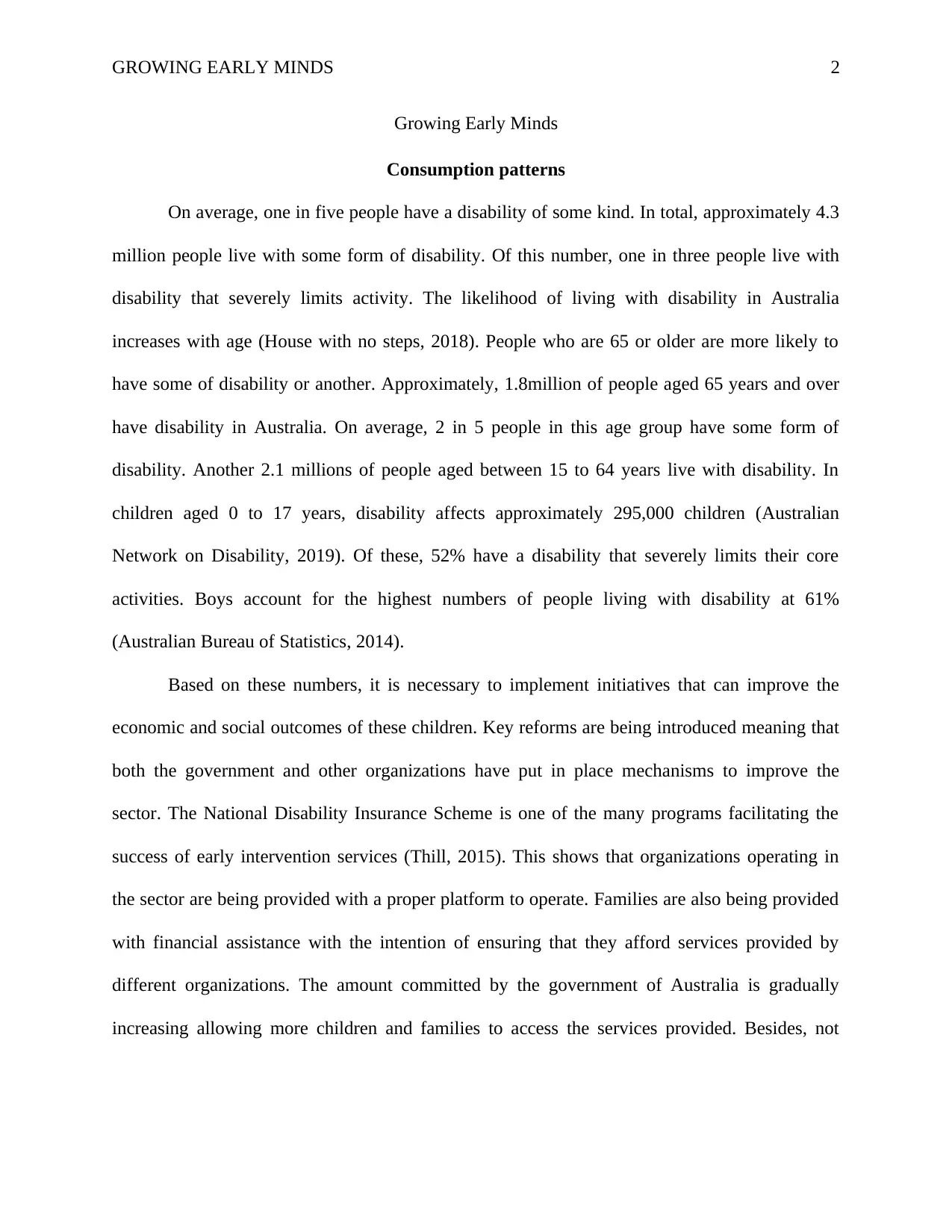
GROWING EARLY MINDS 2
Growing Early Minds
Consumption patterns
On average, one in five people have a disability of some kind. In total, approximately 4.3
million people live with some form of disability. Of this number, one in three people live with
disability that severely limits activity. The likelihood of living with disability in Australia
increases with age (House with no steps, 2018). People who are 65 or older are more likely to
have some of disability or another. Approximately, 1.8million of people aged 65 years and over
have disability in Australia. On average, 2 in 5 people in this age group have some form of
disability. Another 2.1 millions of people aged between 15 to 64 years live with disability. In
children aged 0 to 17 years, disability affects approximately 295,000 children (Australian
Network on Disability, 2019). Of these, 52% have a disability that severely limits their core
activities. Boys account for the highest numbers of people living with disability at 61%
(Australian Bureau of Statistics, 2014).
Based on these numbers, it is necessary to implement initiatives that can improve the
economic and social outcomes of these children. Key reforms are being introduced meaning that
both the government and other organizations have put in place mechanisms to improve the
sector. The National Disability Insurance Scheme is one of the many programs facilitating the
success of early intervention services (Thill, 2015). This shows that organizations operating in
the sector are being provided with a proper platform to operate. Families are also being provided
with financial assistance with the intention of ensuring that they afford services provided by
different organizations. The amount committed by the government of Australia is gradually
increasing allowing more children and families to access the services provided. Besides, not
Growing Early Minds
Consumption patterns
On average, one in five people have a disability of some kind. In total, approximately 4.3
million people live with some form of disability. Of this number, one in three people live with
disability that severely limits activity. The likelihood of living with disability in Australia
increases with age (House with no steps, 2018). People who are 65 or older are more likely to
have some of disability or another. Approximately, 1.8million of people aged 65 years and over
have disability in Australia. On average, 2 in 5 people in this age group have some form of
disability. Another 2.1 millions of people aged between 15 to 64 years live with disability. In
children aged 0 to 17 years, disability affects approximately 295,000 children (Australian
Network on Disability, 2019). Of these, 52% have a disability that severely limits their core
activities. Boys account for the highest numbers of people living with disability at 61%
(Australian Bureau of Statistics, 2014).
Based on these numbers, it is necessary to implement initiatives that can improve the
economic and social outcomes of these children. Key reforms are being introduced meaning that
both the government and other organizations have put in place mechanisms to improve the
sector. The National Disability Insurance Scheme is one of the many programs facilitating the
success of early intervention services (Thill, 2015). This shows that organizations operating in
the sector are being provided with a proper platform to operate. Families are also being provided
with financial assistance with the intention of ensuring that they afford services provided by
different organizations. The amount committed by the government of Australia is gradually
increasing allowing more children and families to access the services provided. Besides, not
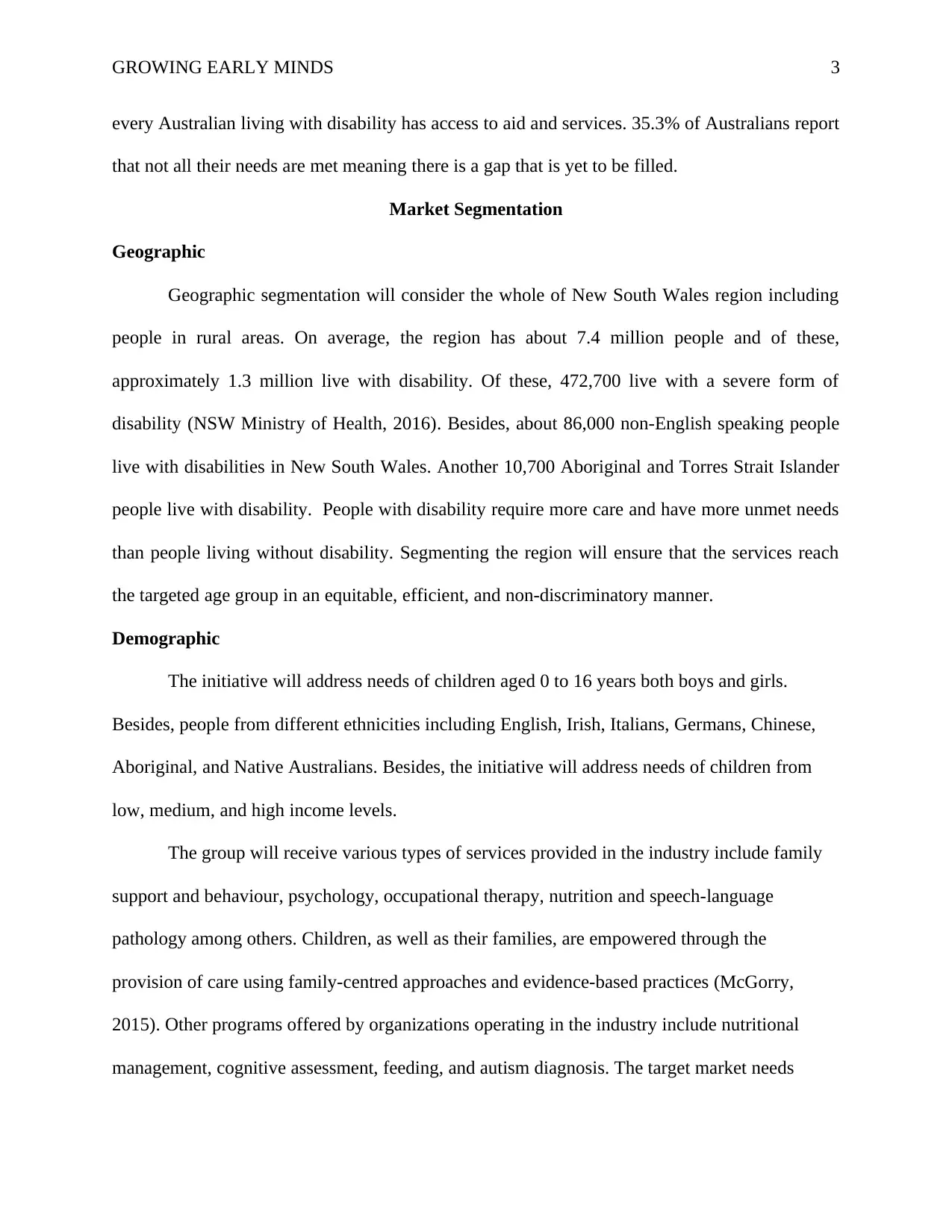
GROWING EARLY MINDS 3
every Australian living with disability has access to aid and services. 35.3% of Australians report
that not all their needs are met meaning there is a gap that is yet to be filled.
Market Segmentation
Geographic
Geographic segmentation will consider the whole of New South Wales region including
people in rural areas. On average, the region has about 7.4 million people and of these,
approximately 1.3 million live with disability. Of these, 472,700 live with a severe form of
disability (NSW Ministry of Health, 2016). Besides, about 86,000 non-English speaking people
live with disabilities in New South Wales. Another 10,700 Aboriginal and Torres Strait Islander
people live with disability. People with disability require more care and have more unmet needs
than people living without disability. Segmenting the region will ensure that the services reach
the targeted age group in an equitable, efficient, and non-discriminatory manner.
Demographic
The initiative will address needs of children aged 0 to 16 years both boys and girls.
Besides, people from different ethnicities including English, Irish, Italians, Germans, Chinese,
Aboriginal, and Native Australians. Besides, the initiative will address needs of children from
low, medium, and high income levels.
The group will receive various types of services provided in the industry include family
support and behaviour, psychology, occupational therapy, nutrition and speech-language
pathology among others. Children, as well as their families, are empowered through the
provision of care using family-centred approaches and evidence-based practices (McGorry,
2015). Other programs offered by organizations operating in the industry include nutritional
management, cognitive assessment, feeding, and autism diagnosis. The target market needs
every Australian living with disability has access to aid and services. 35.3% of Australians report
that not all their needs are met meaning there is a gap that is yet to be filled.
Market Segmentation
Geographic
Geographic segmentation will consider the whole of New South Wales region including
people in rural areas. On average, the region has about 7.4 million people and of these,
approximately 1.3 million live with disability. Of these, 472,700 live with a severe form of
disability (NSW Ministry of Health, 2016). Besides, about 86,000 non-English speaking people
live with disabilities in New South Wales. Another 10,700 Aboriginal and Torres Strait Islander
people live with disability. People with disability require more care and have more unmet needs
than people living without disability. Segmenting the region will ensure that the services reach
the targeted age group in an equitable, efficient, and non-discriminatory manner.
Demographic
The initiative will address needs of children aged 0 to 16 years both boys and girls.
Besides, people from different ethnicities including English, Irish, Italians, Germans, Chinese,
Aboriginal, and Native Australians. Besides, the initiative will address needs of children from
low, medium, and high income levels.
The group will receive various types of services provided in the industry include family
support and behaviour, psychology, occupational therapy, nutrition and speech-language
pathology among others. Children, as well as their families, are empowered through the
provision of care using family-centred approaches and evidence-based practices (McGorry,
2015). Other programs offered by organizations operating in the industry include nutritional
management, cognitive assessment, feeding, and autism diagnosis. The target market needs
⊘ This is a preview!⊘
Do you want full access?
Subscribe today to unlock all pages.

Trusted by 1+ million students worldwide
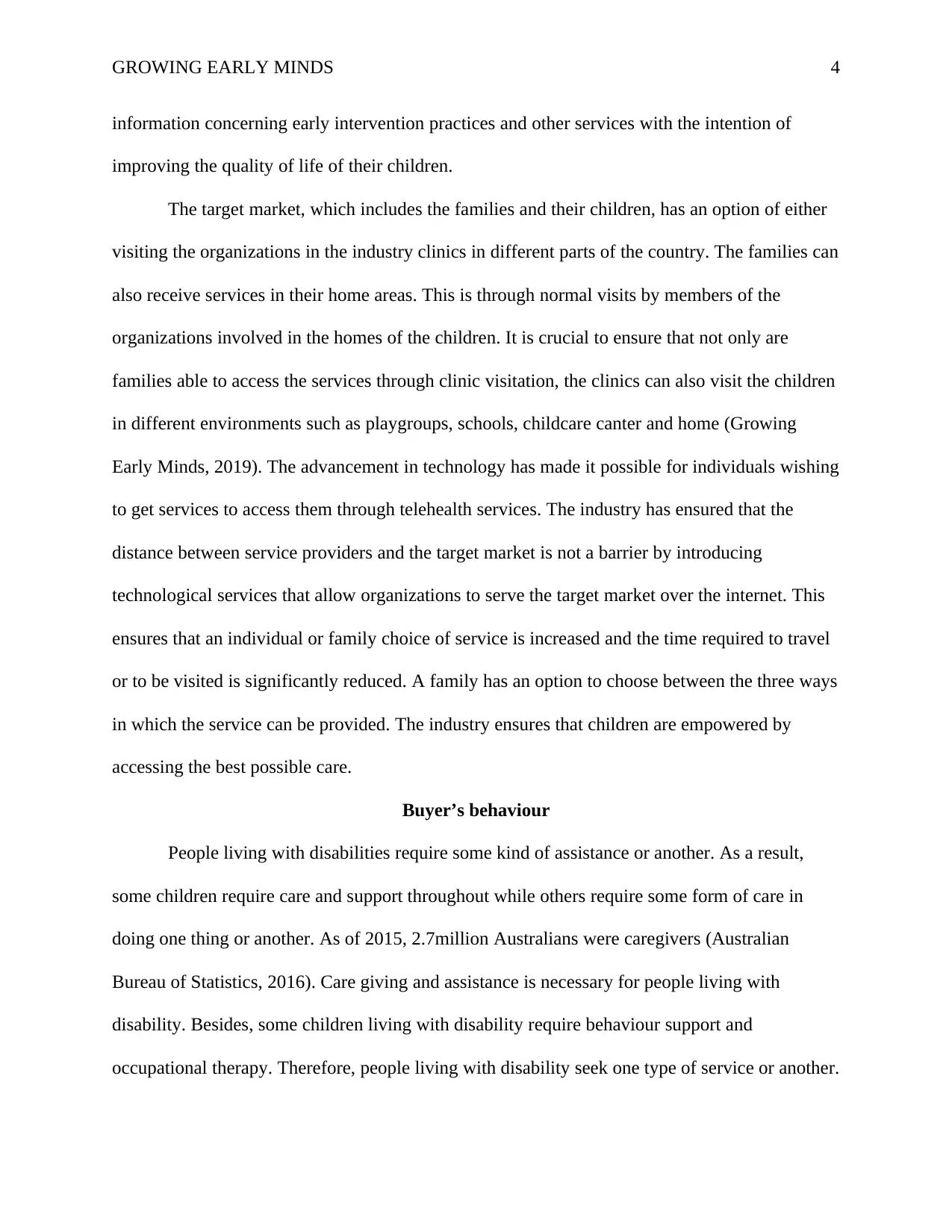
GROWING EARLY MINDS 4
information concerning early intervention practices and other services with the intention of
improving the quality of life of their children.
The target market, which includes the families and their children, has an option of either
visiting the organizations in the industry clinics in different parts of the country. The families can
also receive services in their home areas. This is through normal visits by members of the
organizations involved in the homes of the children. It is crucial to ensure that not only are
families able to access the services through clinic visitation, the clinics can also visit the children
in different environments such as playgroups, schools, childcare canter and home (Growing
Early Minds, 2019). The advancement in technology has made it possible for individuals wishing
to get services to access them through telehealth services. The industry has ensured that the
distance between service providers and the target market is not a barrier by introducing
technological services that allow organizations to serve the target market over the internet. This
ensures that an individual or family choice of service is increased and the time required to travel
or to be visited is significantly reduced. A family has an option to choose between the three ways
in which the service can be provided. The industry ensures that children are empowered by
accessing the best possible care.
Buyer’s behaviour
People living with disabilities require some kind of assistance or another. As a result,
some children require care and support throughout while others require some form of care in
doing one thing or another. As of 2015, 2.7million Australians were caregivers (Australian
Bureau of Statistics, 2016). Care giving and assistance is necessary for people living with
disability. Besides, some children living with disability require behaviour support and
occupational therapy. Therefore, people living with disability seek one type of service or another.
information concerning early intervention practices and other services with the intention of
improving the quality of life of their children.
The target market, which includes the families and their children, has an option of either
visiting the organizations in the industry clinics in different parts of the country. The families can
also receive services in their home areas. This is through normal visits by members of the
organizations involved in the homes of the children. It is crucial to ensure that not only are
families able to access the services through clinic visitation, the clinics can also visit the children
in different environments such as playgroups, schools, childcare canter and home (Growing
Early Minds, 2019). The advancement in technology has made it possible for individuals wishing
to get services to access them through telehealth services. The industry has ensured that the
distance between service providers and the target market is not a barrier by introducing
technological services that allow organizations to serve the target market over the internet. This
ensures that an individual or family choice of service is increased and the time required to travel
or to be visited is significantly reduced. A family has an option to choose between the three ways
in which the service can be provided. The industry ensures that children are empowered by
accessing the best possible care.
Buyer’s behaviour
People living with disabilities require some kind of assistance or another. As a result,
some children require care and support throughout while others require some form of care in
doing one thing or another. As of 2015, 2.7million Australians were caregivers (Australian
Bureau of Statistics, 2016). Care giving and assistance is necessary for people living with
disability. Besides, some children living with disability require behaviour support and
occupational therapy. Therefore, people living with disability seek one type of service or another.
Paraphrase This Document
Need a fresh take? Get an instant paraphrase of this document with our AI Paraphraser
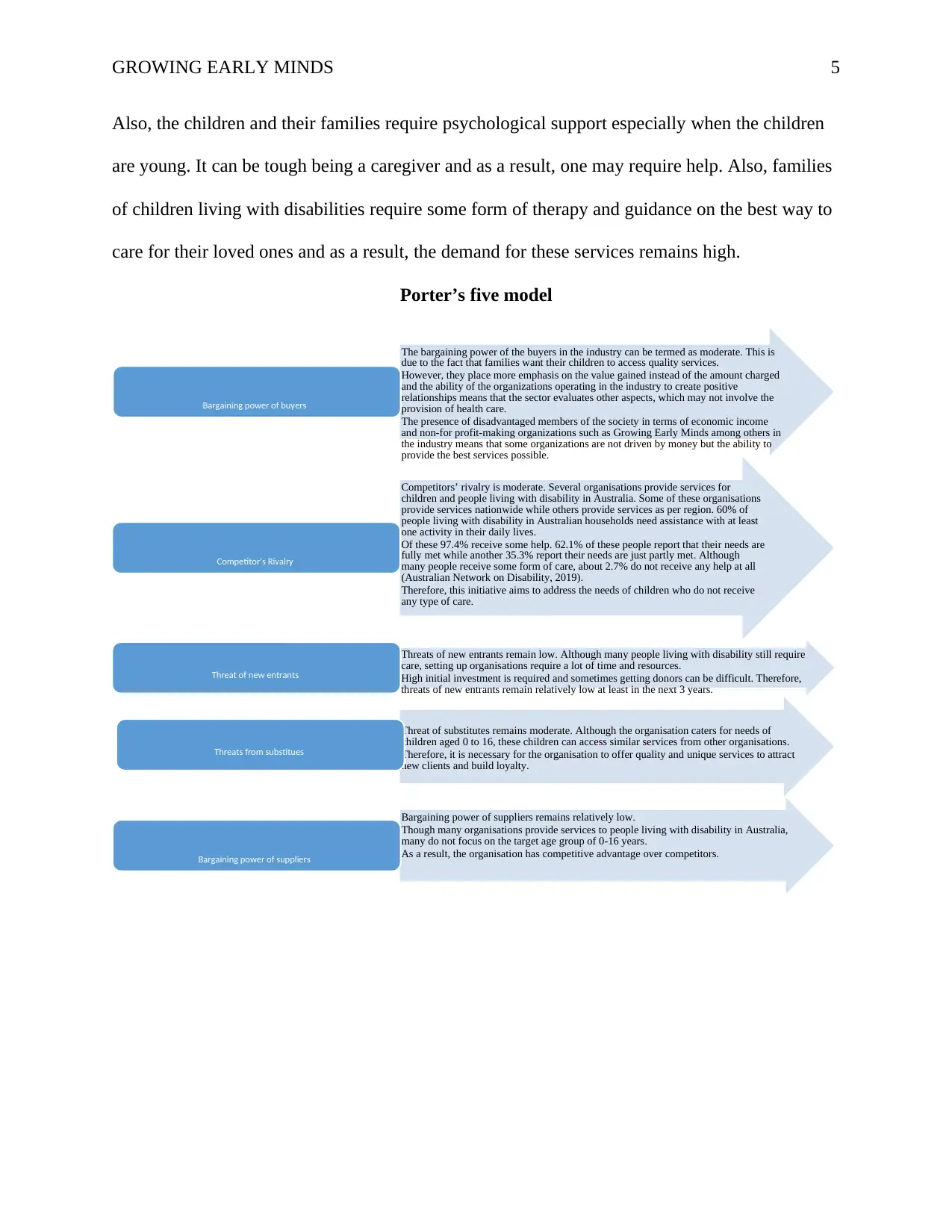
The bargaining power of the buyers in the industry can be termed as moderate. This is
due to the fact that families want their children to access quality services.
However, they place more emphasis on the value gained instead of the amount charged
and the ability of the organizations operating in the industry to create positive
relationships means that the sector evaluates other aspects, which may not involve the
provision of health care.
The presence of disadvantaged members of the society in terms of economic income
and non-for profit-making organizations such as Growing Early Minds among others in
the industry means that some organizations are not driven by money but the ability to
provide the best services possible.
Bargaining power of buyers
Competitors’ rivalry is moderate. Several organisations provide services for
children and people living with disability in Australia. Some of these organisations
provide services nationwide while others provide services as per region. 60% of
people living with disability in Australian households need assistance with at least
one activity in their daily lives.
Of these 97.4% receive some help. 62.1% of these people report that their needs are
fully met while another 35.3% report their needs are just partly met. Although
many people receive some form of care, about 2.7% do not receive any help at all
(Australian Network on Disability, 2019).
Therefore, this initiative aims to address the needs of children who do not receive
any type of care.
Competitor's Rivalry
Threats of new entrants remain low. Although many people living with disability still require
care, setting up organisations require a lot of time and resources.
High initial investment is required and sometimes getting donors can be difficult. Therefore,
threats of new entrants remain relatively low at least in the next 3 years.
Threat of new entrants
Threat of substitutes remains moderate. Although the organisation caters for needs of
children aged 0 to 16, these children can access similar services from other organisations.
Therefore, it is necessary for the organisation to offer quality and unique services to attract
new clients and build loyalty.
Threats from substitues
Bargaining power of suppliers remains relatively low.
Though many organisations provide services to people living with disability in Australia,
many do not focus on the target age group of 0-16 years.
As a result, the organisation has competitive advantage over competitors.Bargaining power of suppliers
GROWING EARLY MINDS 5
Also, the children and their families require psychological support especially when the children
are young. It can be tough being a caregiver and as a result, one may require help. Also, families
of children living with disabilities require some form of therapy and guidance on the best way to
care for their loved ones and as a result, the demand for these services remains high.
Porter’s five model
due to the fact that families want their children to access quality services.
However, they place more emphasis on the value gained instead of the amount charged
and the ability of the organizations operating in the industry to create positive
relationships means that the sector evaluates other aspects, which may not involve the
provision of health care.
The presence of disadvantaged members of the society in terms of economic income
and non-for profit-making organizations such as Growing Early Minds among others in
the industry means that some organizations are not driven by money but the ability to
provide the best services possible.
Bargaining power of buyers
Competitors’ rivalry is moderate. Several organisations provide services for
children and people living with disability in Australia. Some of these organisations
provide services nationwide while others provide services as per region. 60% of
people living with disability in Australian households need assistance with at least
one activity in their daily lives.
Of these 97.4% receive some help. 62.1% of these people report that their needs are
fully met while another 35.3% report their needs are just partly met. Although
many people receive some form of care, about 2.7% do not receive any help at all
(Australian Network on Disability, 2019).
Therefore, this initiative aims to address the needs of children who do not receive
any type of care.
Competitor's Rivalry
Threats of new entrants remain low. Although many people living with disability still require
care, setting up organisations require a lot of time and resources.
High initial investment is required and sometimes getting donors can be difficult. Therefore,
threats of new entrants remain relatively low at least in the next 3 years.
Threat of new entrants
Threat of substitutes remains moderate. Although the organisation caters for needs of
children aged 0 to 16, these children can access similar services from other organisations.
Therefore, it is necessary for the organisation to offer quality and unique services to attract
new clients and build loyalty.
Threats from substitues
Bargaining power of suppliers remains relatively low.
Though many organisations provide services to people living with disability in Australia,
many do not focus on the target age group of 0-16 years.
As a result, the organisation has competitive advantage over competitors.Bargaining power of suppliers
GROWING EARLY MINDS 5
Also, the children and their families require psychological support especially when the children
are young. It can be tough being a caregiver and as a result, one may require help. Also, families
of children living with disabilities require some form of therapy and guidance on the best way to
care for their loved ones and as a result, the demand for these services remains high.
Porter’s five model
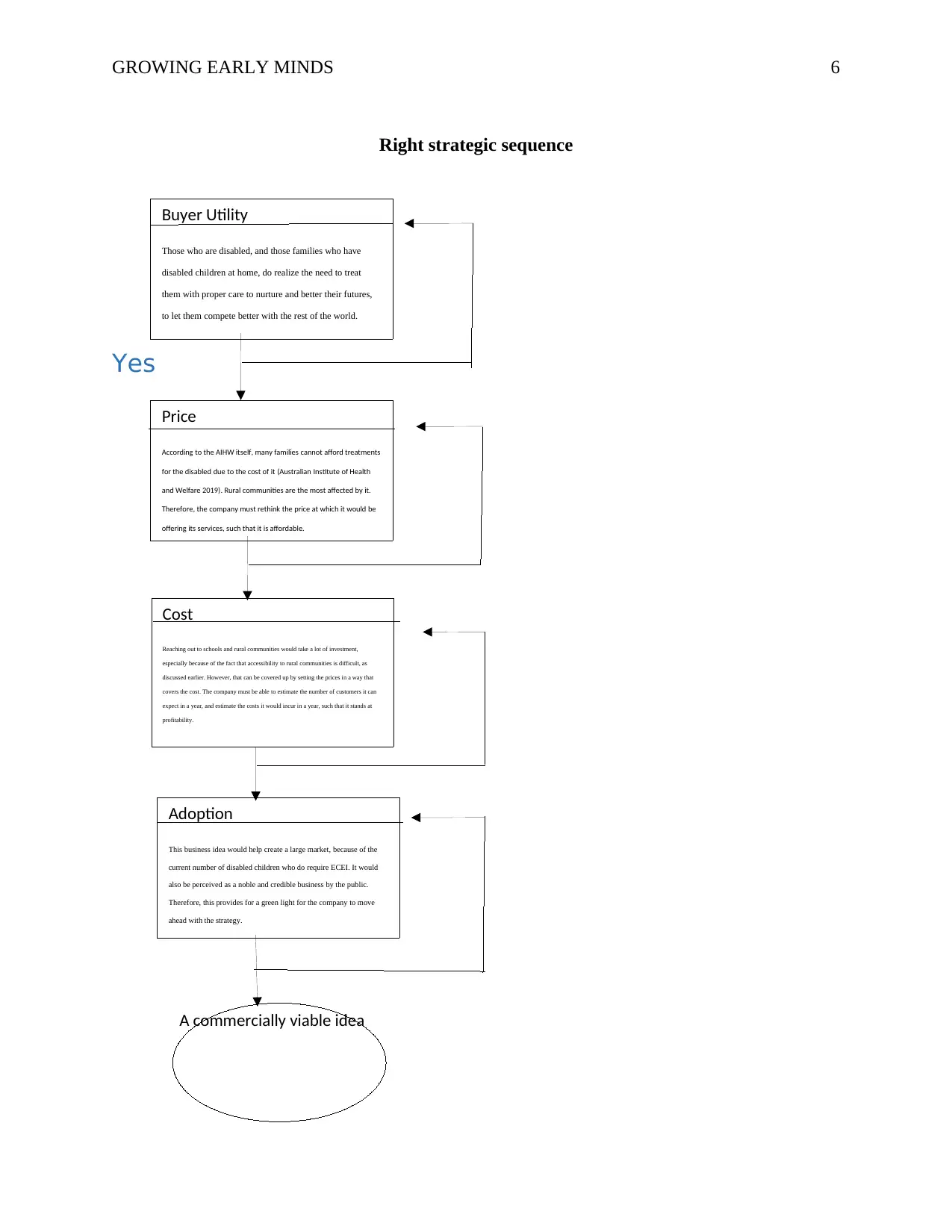
GROWING EARLY MINDS 6
Right strategic sequence
Yes
Buyer Utility
Those who are disabled, and those families who have
disabled children at home, do realize the need to treat
them with proper care to nurture and better their futures,
to let them compete better with the rest of the world.
Hence, the utility offered by the company is high.
Price
According to the AIHW itself, many families cannot afford treatments
for the disabled due to the cost of it (Australian Institute of Health
and Welfare 2019). Rural communities are the most affected by it.
Therefore, the company must rethink the price at which it would be
offering its services, such that it is affordable.
Cost
Reaching out to schools and rural communities would take a lot of investment,
especially because of the fact that accessibility to rural communities is difficult, as
discussed earlier. However, that can be covered up by setting the prices in a way that
covers the cost. The company must be able to estimate the number of customers it can
expect in a year, and estimate the costs it would incur in a year, such that it stands at
profitability.
Adoption
This business idea would help create a large market, because of the
current number of disabled children who do require ECEI. It would
also be perceived as a noble and credible business by the public.
Therefore, this provides for a green light for the company to move
ahead with the strategy.
A commercially viable idea
Right strategic sequence
Yes
Buyer Utility
Those who are disabled, and those families who have
disabled children at home, do realize the need to treat
them with proper care to nurture and better their futures,
to let them compete better with the rest of the world.
Hence, the utility offered by the company is high.
Price
According to the AIHW itself, many families cannot afford treatments
for the disabled due to the cost of it (Australian Institute of Health
and Welfare 2019). Rural communities are the most affected by it.
Therefore, the company must rethink the price at which it would be
offering its services, such that it is affordable.
Cost
Reaching out to schools and rural communities would take a lot of investment,
especially because of the fact that accessibility to rural communities is difficult, as
discussed earlier. However, that can be covered up by setting the prices in a way that
covers the cost. The company must be able to estimate the number of customers it can
expect in a year, and estimate the costs it would incur in a year, such that it stands at
profitability.
Adoption
This business idea would help create a large market, because of the
current number of disabled children who do require ECEI. It would
also be perceived as a noble and credible business by the public.
Therefore, this provides for a green light for the company to move
ahead with the strategy.
A commercially viable idea
⊘ This is a preview!⊘
Do you want full access?
Subscribe today to unlock all pages.

Trusted by 1+ million students worldwide
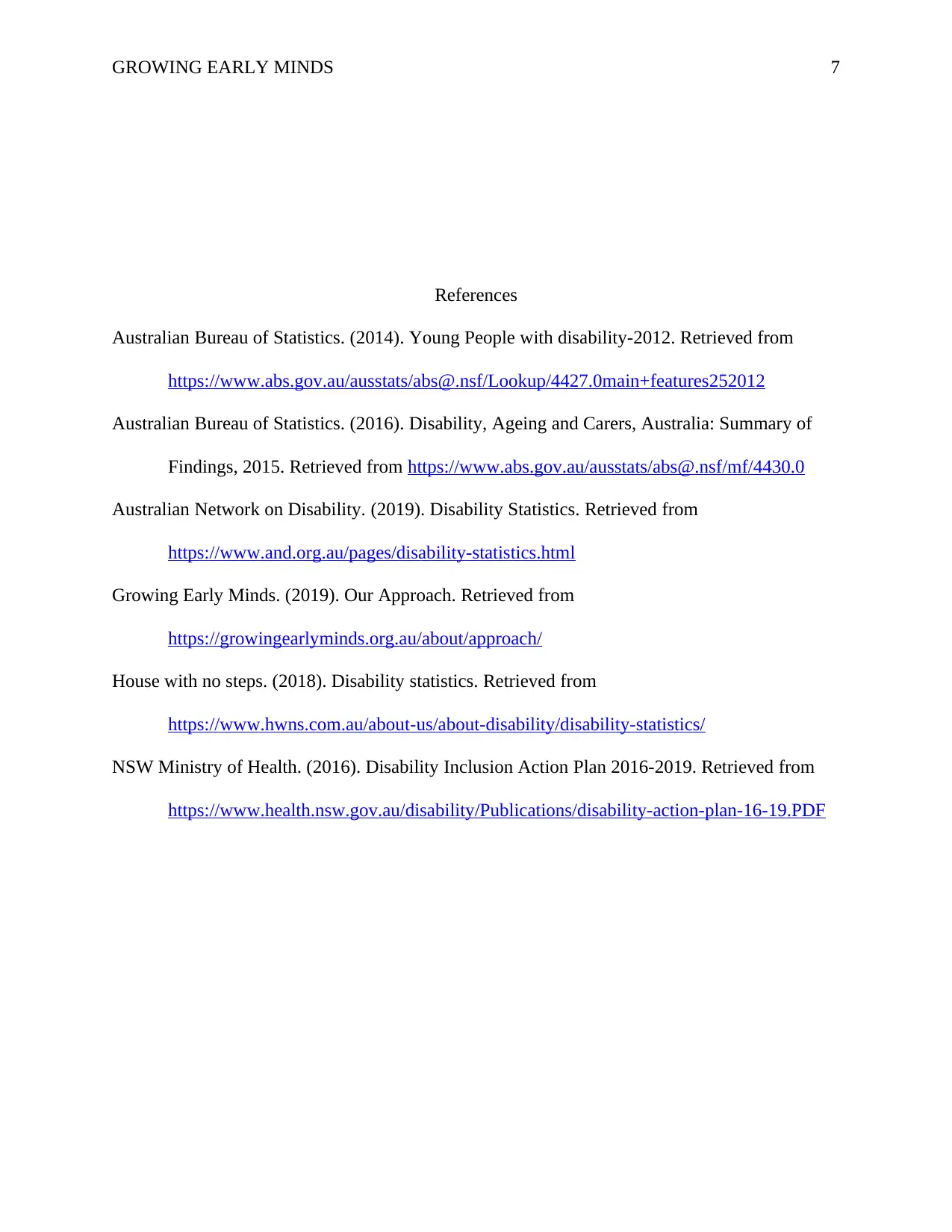
GROWING EARLY MINDS 7
References
Australian Bureau of Statistics. (2014). Young People with disability-2012. Retrieved from
https://www.abs.gov.au/ausstats/abs@.nsf/Lookup/4427.0main+features252012
Australian Bureau of Statistics. (2016). Disability, Ageing and Carers, Australia: Summary of
Findings, 2015. Retrieved from https://www.abs.gov.au/ausstats/abs@.nsf/mf/4430.0
Australian Network on Disability. (2019). Disability Statistics. Retrieved from
https://www.and.org.au/pages/disability-statistics.html
Growing Early Minds. (2019). Our Approach. Retrieved from
https://growingearlyminds.org.au/about/approach/
House with no steps. (2018). Disability statistics. Retrieved from
https://www.hwns.com.au/about-us/about-disability/disability-statistics/
NSW Ministry of Health. (2016). Disability Inclusion Action Plan 2016-2019. Retrieved from
https://www.health.nsw.gov.au/disability/Publications/disability-action-plan-16-19.PDF
References
Australian Bureau of Statistics. (2014). Young People with disability-2012. Retrieved from
https://www.abs.gov.au/ausstats/abs@.nsf/Lookup/4427.0main+features252012
Australian Bureau of Statistics. (2016). Disability, Ageing and Carers, Australia: Summary of
Findings, 2015. Retrieved from https://www.abs.gov.au/ausstats/abs@.nsf/mf/4430.0
Australian Network on Disability. (2019). Disability Statistics. Retrieved from
https://www.and.org.au/pages/disability-statistics.html
Growing Early Minds. (2019). Our Approach. Retrieved from
https://growingearlyminds.org.au/about/approach/
House with no steps. (2018). Disability statistics. Retrieved from
https://www.hwns.com.au/about-us/about-disability/disability-statistics/
NSW Ministry of Health. (2016). Disability Inclusion Action Plan 2016-2019. Retrieved from
https://www.health.nsw.gov.au/disability/Publications/disability-action-plan-16-19.PDF
Paraphrase This Document
Need a fresh take? Get an instant paraphrase of this document with our AI Paraphraser
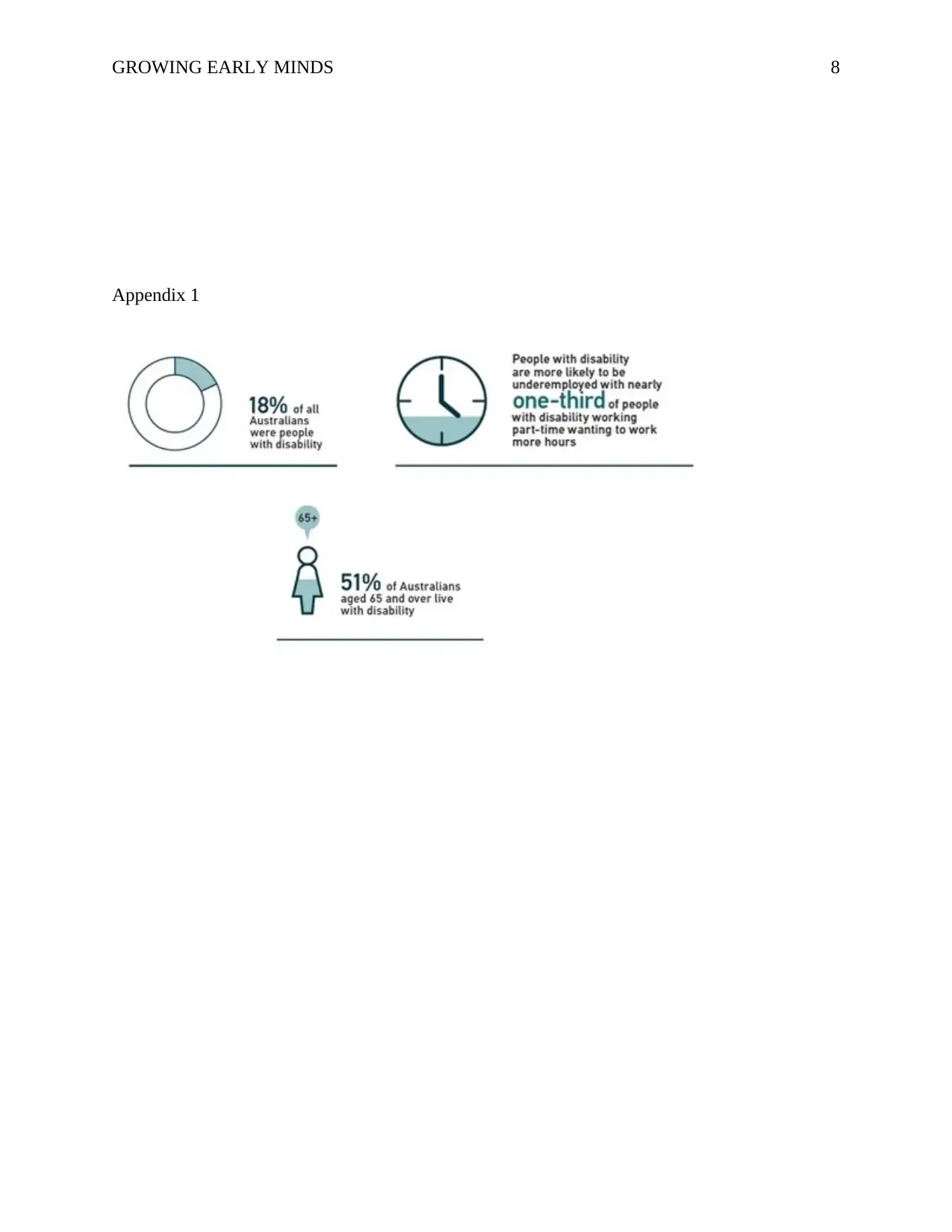
GROWING EARLY MINDS 8
Appendix 1
Appendix 1
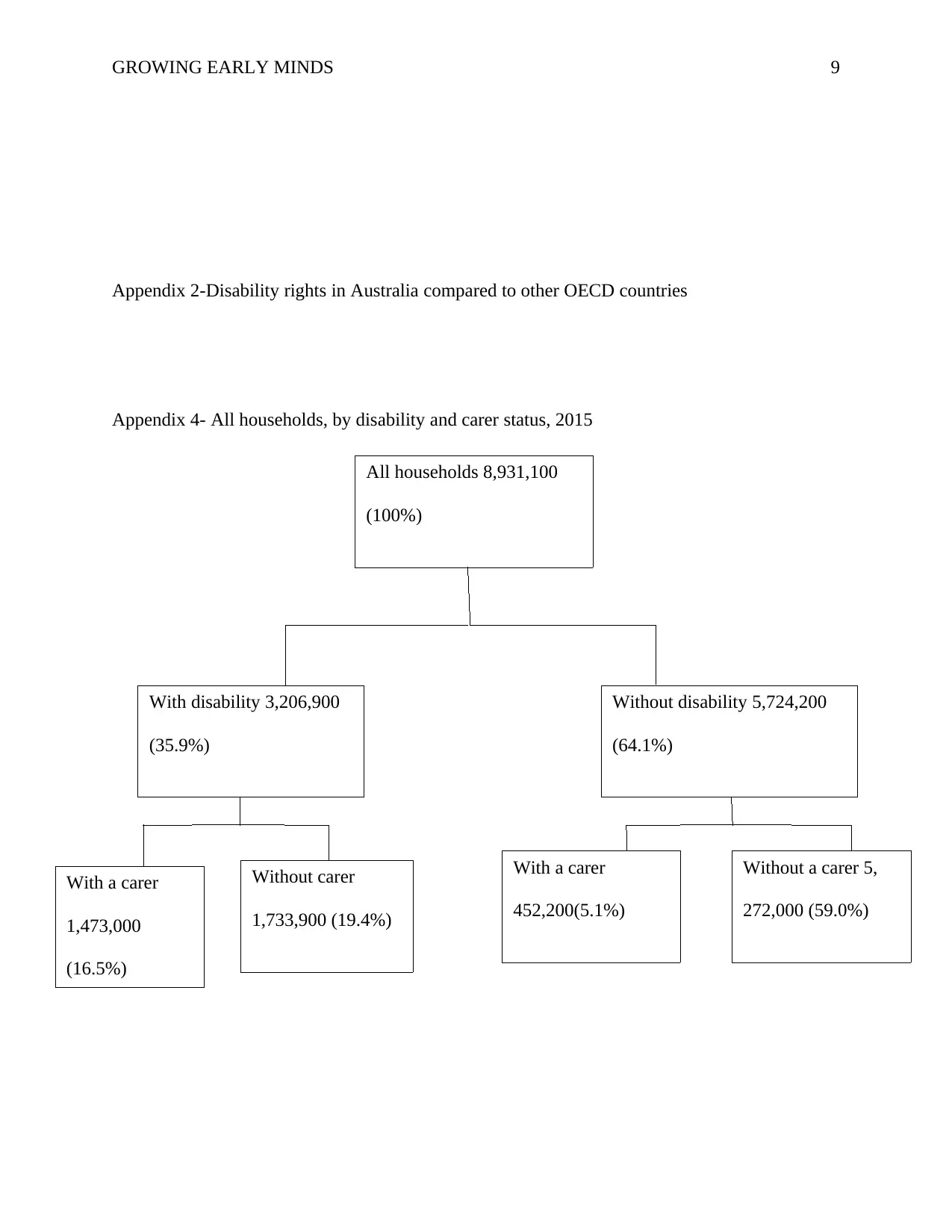
GROWING EARLY MINDS 9
Appendix 2-Disability rights in Australia compared to other OECD countries
Appendix 4- All households, by disability and carer status, 2015
All households 8,931,100
(100%)
With disability 3,206,900
(35.9%)
Without disability 5,724,200
(64.1%)
With a carer
1,473,000
(16.5%)
Without carer
1,733,900 (19.4%)
With a carer
452,200(5.1%)
Without a carer 5,
272,000 (59.0%)
Appendix 2-Disability rights in Australia compared to other OECD countries
Appendix 4- All households, by disability and carer status, 2015
All households 8,931,100
(100%)
With disability 3,206,900
(35.9%)
Without disability 5,724,200
(64.1%)
With a carer
1,473,000
(16.5%)
Without carer
1,733,900 (19.4%)
With a carer
452,200(5.1%)
Without a carer 5,
272,000 (59.0%)
⊘ This is a preview!⊘
Do you want full access?
Subscribe today to unlock all pages.

Trusted by 1+ million students worldwide
1 out of 9
Related Documents
Your All-in-One AI-Powered Toolkit for Academic Success.
+13062052269
info@desklib.com
Available 24*7 on WhatsApp / Email
![[object Object]](/_next/static/media/star-bottom.7253800d.svg)
Unlock your academic potential
Copyright © 2020–2025 A2Z Services. All Rights Reserved. Developed and managed by ZUCOL.





